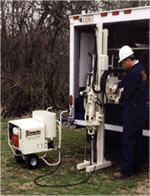Using Oxygen to Enhance Biodegradation of Contaminants - Lessons Learned
Adding oxygen to ground water contaminated by gasoline spills or leaking underground storage tanks is a common approach for site remediation. Since the late 1980s, it has been known that adding oxygen to contaminant plumes promotes the aerobic biodegradation of petroleum contaminants such as gasoline. On the other hand, the addition of oxygen to anoxic ground water does not always result in increased aerobic biodegradation. For example, the Toxic Substances Hydrology Program’s investigation of oxygen-based remediation at a leaking underground storage tank located in Laurel Bay, South Carolina, produced distinctly different results for contaminant cleanup in different locations. In one area near the site of the tank (source area), an oxygen-release compound
 Oxygen Injection
Oxygen Injection |
|
injected into the subsurface did not increase the low levels of dissolved oxygen (DO); therefore, concentrations of BTEX and methyl tert-butyl ether (MTBE) remained relatively unchanged. Conversely, the same oxygen-release compound injected less than 200 meters downgradient rapidly increased DO levels, and BTEX and MTBE concentrations rapidly decreased. These different results were found to relate to differences in the consumption of oxygen between the two areas. Differences in infiltration, microbial community makeup, and chemistry of the sediments caused the source area site to consume the oxygen before it had a chance to create conditions suitable for the aerobic biodegradation of the contaminants. "The results of this investigation indicate the important role the pre-existing hydrologic, geochemical, and microbiologic conditions have on the outcome of oxygen-based remediation strategies, and suggest that these properties should be evaluated prior to the implementation of oxygen-based remedial strategies" (Landmeyer and Bradley, 2003). This is an important lesson for clean-up professionals using oxygen to enhance the biodegradation of contaminants at remediation sites.
Differences Between Remediation Sites
|
Source Area Remediation Site
|
Downgradient Remediation Site
|
| Located in the plume source area |
Less than 200 meters downgradient from source area |
| Anoxic conditions |
Anoxic conditions |
| Land surface is pavement |
Land surface is grass |
| No or limited infiltration of rainwater |
Infiltration of rainwater |
| No exposure to oxygen |
Periodic exposure to oxygen |
| Microbial community adapted to consistent anoxic conditions |
Microbial community adapted to brief exposure to oxygen |
| High levels of oxidizable material |
Low levels of oxidizable material |
References
Landmeyer, J.E., and Bradley, P.M., 2003, Effect of hydrologic and geochemical conditions on oxygen-enhanced bioremediation in a gasoline-contaminated aquifer: Bioremediation Journal, v. 7, no. 3-4, p. 165-177.
Landmeyer, J.E., Chapelle, F.H., Herlong, H.H., and Bradley, P.M., 2001, Methyl tert-butyl ether biodegradation by indigenous aquifer microorganisms under natural and artificial oxic conditions: Environmental Science and Technology, v. 35, n. 6, p. 1118-1126.
More Information
- Using Oxygen to Clean Up Ground-Water Contamination
- Processes Affecting the Natural Attenuation of Fuels in Ground Water -- Fuel Oxygenates -- Laurel Bay, South Carolina
- Oxygen-Release Compound Remediation Tests, Laurel Bay, South Carolina
- Quanitfying Natural Attenuation at the Plume Scale, Galloway Township, New Jersey; Laurel Bay, South Carolina
- Oxygen-enhanced bioremediation in a gasolinecontaminated aquifer: Underground Tank Technology Update, 2005, vol. 19, no. 3, p. 4-6.
- Crosscutting Information on Site Remediation
Related Headlines
Back to Headlines page
|

|